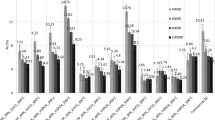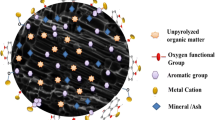Abstract
Recovering silica from rice husks by calcination is an economical and attractive method of manufacturing high value-added products. The pretreatment process plays an important role in the preparation of amorphous silica by influencing both the removal of metallic impurities and further decomposition of organic compounds. In this paper, the pyrolysis kinetics of various pretreatment processes, including water soaking, acid leaching and grinding, were investigated using thermogravimetric analysis. The contributions of various pretreatment to the production of silica can be listed as follows: acid leaching > water soaking > grinding. Acid leaching at 120 °C with an acid concentration of 8 mass% and grinding raw material into 100 mesh was most beneficial to the removal of metallic impurities and thermal decomposition of organic compounds. The Flynn–Wall–Ozawa method was employed to derive the kinetic parameters (activation energy and correlation coefficient). The activation energies were calculated to be in the range of 90–156 kJ mol−1 for rice husks with various pretreatments at different conversion fractions. These results provide useful information for the rational design and scaling up of pretreatment reactors.





Similar content being viewed by others
References
Food and Agriculture Organization of the United Nations (FAO). World food situation, FAO cereal supply and demand brief. 2014.
Rahhal V, Cabrera O, Talero R, Delgado A. Calorimetry of portland cement with silica fume and gypsum additions. J Therm Anal Cal. 2007;87(2):331–7.
Kurama S, Kurama H. The reaction kinetics of rice husk based cordierite ceramics. Ceram Int. 2008;34(2):269–72.
Salavati-Niasari M, Javidi J, Dadkhah M. Ball milling synthesis of silica nanoparticle from rice husk ash for drug delivery application. Comb Chem High Throughput Screen. 2013;16(6):458–62.
Awizar DA, Othman NK, Jalar A, Daud AR, Rahman IA, Al-Hardan NH. Nanosilicate extraction from rice husk ash as green corrosion inhibitor. Int J Electrochem Sci. 2013;8(2):1759–69.
Janowska G, Rybiński P, Jantas R. Effect of the modification of silica on thermal properties and flammability of cross-linked butadiene–acrylonitrile rubbers. J Therm Anal Cal. 2007;87(2):511–7.
Rajamani D, Surender R, Mahendran A, Muthusubramanian S, Vijayakumar C. Bismaleimide/rice husk silica reinforced composites. J Therm Anal Cal. 2013;114(2):883–93.
Adam F, Appaturi JN, Khanam Z, Thankappan R, Nawi MAM. Utilization of tin and titanium incorporated rice husk silica nanocomposite as photocatalyst and adsorbent for the removal of methylene blue in aqueous medium. Appl Surf Sci. 2013;264:718–26.
Liou T-H, Yang C-C. Synthesis and surface characteristics of nanosilica produced from alkali-extracted rice husk ash. Mater Sci Eng B. 2011;176(7):521–9.
Zulkifli NSC, Rahman IA, Mohamad D, Husein A. A green sol–gel route for the synthesis of structurally controlled silica particles from rice husk for dental composite filler. Ceram Int. 2013;39(4):4559–67.
Ma X, Zhou B, Gao W, Qu Y, Wang L, Wang Z, et al. A recyclable method for production of pure silica from rice hull ash. Powder Technol. 2012;217:497–501.
Kapur PC. Production of reactive bio-silica from the combustion of rice husk in a tube-in-basket (TiB) burner. Powder Technol. 1985;44(1):63–7.
Umeda J, Kondoh K. High-purification of amorphous silica originated from rice husks by combination of polysaccharide hydrolysis and metallic impurities removal. Ind Crop Prod. 2010;32(3):539–44.
Chen HR, Wang WX, Martin JC, Oliphant AJ, Doerr PA, Xu JF, et al. Extraction of lignocellulose and synthesis of porous silica nanoparticles from rice husks: a comprehensive utilization of rice husk biomass. ACS Sustain Chem Eng. 2013;1(2):254–9.
Wang W, Martin JC, Fan X, Han A, Luo Z, Sun L. Silica nanoparticles and frameworks from rice husk biomass. ACS Appl Mater Interfaces. 2011;4(2):977–81.
Shen J, Liu X, Zhu S, Zhang H, Tan J. Effects of calcination parameters on the silica phase of original and leached rice husk ash. Mater Lett. 2011;65(8):1179–83.
Liou T-H. Preparation and characterization of nano-structured silica from rice husk. Mater Sci Eng A. 2004;364(1–2):313–23.
Ang TN, Ngoh GC, Chua ASM. Comparative study of various pretreatment reagents on rice husk and structural changes assessment of the optimized pretreated rice husk. Bioresour Technol. 2013;135:116–9.
Yalçin N, Sevinç V. Studies on silica obtained from rice husk. Ceram Int. 2001;27(2):219–24.
Patel M, Karera A, Prasanna P. Effect of thermal and chemical treatments on carbon and silica contents in rice husk. J Mater Sci. 1987;22(7):2457–64.
Javed SH, Naveed S, Ramzan N, Feroze N, Zafar M. Characterization of amorphous silica obtained from KMnO4 treated rice husk. J Chem Soc Pak. 2010;32(1):78–82.
Liou T-H. Evolution of chemistry and morphology during the carbonization and combustion of rice husk. Carbon. 2004;42(4):785–94.
Gu S, Zhou J, Luo Z, Wang Q, Ni M. A detailed study of the effects of pyrolysis temperature and feedstock particle size on the preparation of nanosilica from rice husk. Ind Crop Prod. 2013;50:540–9.
Sbirrazzuoli N, Vincent L, Mija A, Guigo N. Integral, differential and advanced isoconversional methods: complex mechanisms and isothermal predicted conversion–time curves. Chemometr Intell Lab. 2009;96(2):219–26.
Mochidzuki K, Sakoda A, Suzuki M, Izumi J, Tomonaga N. Structural behavior of rice husk silica in pressurized hot-water treatment processes. Ind Eng Chem Res. 2001;40(24):5705–9.
Krishnarao RV, Godkhindi MM. Distribution of silica in rice husks and its effect on the formation of silicon carbide. Ceram Int. 1992;18(4):243–9.
Amorim JA, Eliziário SA, Gouveia DS, Simőes ASM, Santos JCO, Conceiçăo MM, et al. Thermal analysis of the rice and by-products. J Therm Anal Cal. 2004;75(2):393–9.
Biagini E, Barontini F, Tognotti L. Devolatilization of biomass fuels and biomass components studied by TG/FTIR technique. Ind Eng Chem Res. 2006;45(13):4486–93.
Lai Z, Ma X, Tang Y, Lin H, Chen Y. Thermogravimetric analyses of combustion of lignocellulosic materials in N2/O2 and CO2/O2 atmospheres. Bioresour Technol. 2012;107:444–50.
Wang G, Li W, Xue Q, Yi Y, Li B. Thermogravimetric behaviors of biomass’ chemical components under air or syngas. J Fuel Chem Tech. 2009;37(2):170–6.
Xianhua W, Hanping C, Jing W, Fen X, Haiping Y. Influence of mineral matters on biomass pyrolysis characteristics. J Fuel Chem Tech. 2008;36(6):679–83.
Zakharov AI, Belyakov AV, Tsvigunov AN. Forms of extraction of silicon compounds in rice husks. Glass Ceram. 1993;50(9–10):420–5.
Sarangi M, Nayak P, Tiwari TN. Effect of temperature on nano-crystalline silica and carbon composites obtained from rice-husk ash. Compos B. 2011;42(7):1994–8.
Li Z. Influence of alkali and alkaline earth metals on biomass pyrolysis characteristics. Wuhan: Huazhong University of Science and Technology; 2008.
Tan H, Wang S, Luo Z, Cen K. Pyrolysis behavior of cellulose, xylan and lignin. J Fuel Chem Tech. 2006;34(1):61–5.
Carmona VB, Oliveira RM, Silva WTL, Mattoso LHC, Marconcini JM. Nanosilica from rice husk: extraction and characterization. Ind Crop Prod. 2013;43:291–6.
Sonobe T, Worasuwannarak N. Kinetic analyses of biomass pyrolysis using the distributed activation energy model. Fuel. 2008;87(3):414–21.
Acknowledgements
Financial support from the National Key Project of Fundamental Research on Biomass to High-Grade Fuel (2013CB228100) is gratefully acknowledged.
Author information
Authors and Affiliations
Corresponding author
Rights and permissions
About this article
Cite this article
Gu, S., Zhou, J., Luo, Z. et al. Kinetic study on the preparation of silica from rice husk under various pretreatments. J Therm Anal Calorim 119, 2159–2169 (2015). https://doi.org/10.1007/s10973-014-4219-z
Received:
Accepted:
Published:
Issue Date:
DOI: https://doi.org/10.1007/s10973-014-4219-z




